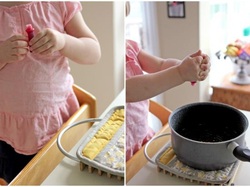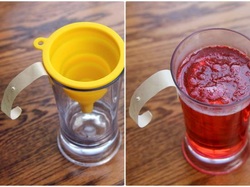
Gummy bears do some interesting things when put into different liquids. We wanted to find out what would happen when we put gummy bears into water, salt water, vinegar, and baking soda water. We measured 50 mls of each liquid & added 1 tbsp. of salt or baking soda:

These are the results one day later
Recording the length before and after would be a good way to asses the changes particularly.
The Science Behind It:
Osmosis is the movement of water from less concentrated solution to equalize the concentration. When the gummy bear is placed in the water, the water will go inside of it (it's higher concentrated) to try & equalize it. It doesn't grow the salt water though because the salt causes the water conentration to be similar to the bear if it grows it will be minimal.

What You Need:
- Tall Glass/Plastic Containers
- Skewers
- Clothespins
- Masking Tape
- Food Coloring
- Sugar (3 1/2 cups)
- Water (2 Cups)

This is a 3-day project prep the night before by sprinkling sugar on the skewers after soaking them in water. Let them dry overnight. The next morning tear off strips of masking tape to go across each glass and then she poked holes in the middle of each tape strip to prep the spot for the skewer placement.

Then pour all the water into a pan. For this next step, a parent step, I boiled the water. Once boiling I added the sugar gradually, about a 1/2 cup at a time stirring constantly until dissolved. Once all the sugar was added, we let the sugar water boil for 10 minutes.

After 10 minutes of boiling we added our food coloring, about 4-5 drops of your desired color. Because the pan was very hot and just off the burner, explain the safety of standing back while dropping in the food coloring (if your child is not quite ready for this step, a parent should do it so as to not risk burning). Let the colored sugar mixture cool for another 10 minutes.

Pull back the masking tape and add the funnel to the glass. For this next step, is to pour in the colored sugar mixture, half of the mixture to each glass.

Place the sugar covered skewers down into the colored sugar water through the preset holes. Then clip on the clothespins to the skewer to keep them in the middle of the glasses, not touching the sides. It is important that the glasses sit untouched for at least two days to allow the sugar to "grow".

Here are rock candies growing on day 2, the left & on day 3, the right. We first started with taller fluted glasses letting them grow for 4 days. The width of the sugar sealed them to the fluted bottoms making them permanently attached to the bottom. On our second attempt we used the same fluted glasses but only let the candy grow for 2 days, thinking this would be the trick. It wasn't - for 2 days or 4 days there wasn't much growth difference & it still sealed the bottom permanently to the base of the candy stick. The above process became our third & final attempt using a non-fluted glass for only 2 days of growth, which turned out perfectly
The Science Behind It: By heating the water and suger you've created a supersaturated solution. This solution is unstable and there is more solvte(sugar) than can stay in liquid form. Thus, the sugar wil come out of solution and form a precipitate. As the water evaporates, the solution becomes more saturated and sugar molecules will comtinue to come out of solution. As they do so, they will collet on the string. As the suger molecules accumulate on top of each other the product is your rock candy.
Source:http://www.kiwicrate.com/projects/Rock-Candy-Science-Experiment/2465

What You Need
Black Pepper
Water
Dish Soap
A Bowl
What To Do
1. Pour water in a shallow bowl
2. Sprinkle ground pepper over the water
3. Dip your finger in the water to show that nothing happens
4. Then pour drop of dish soap on your finger and dip it into the center of the dish of water
5. The pepper will suddenly run to the side!
The
Science Behind It
Water molecules like to "stick" to one another.
There is a difference between a molecule at the surface and one inside,
however, which is known as surface tension. The inside molecules are being pulled in all directions at once while the molecules on top are only being pulled downward. Soap destroys waters high surface tension. The pepper can only float where the surface tension is strong and there isn't soap. When the soap is added the water "scoots" away
and simply carries the pepper along with it.
What You Need
A bar of Ivory brand soap
A microwavable plate

What You Do
1. Place the ivory soap on the microwavable plate.
2. With a knife, cut the bar of soap into pieces.
3. Place plate in microwave for 1-2 minutes
4. Watch and see what happens!

Make sure you let the soap cool because it will be hot, then let the kids play with this fun cloud of soap!


What You Do
1. Download and print the free snake template and draw the design onto the tissue paper.
2. Cut out the snake following the lines you have traced onto the tissue paper.
3. Rub the plastic ruler vigorously over the wool carpet or scarf, then hover the ruler over the snake's head.
4. Watch as the snake rises off the table!
The Science Behind ItMost objects are made of an equal amount of positive charges (protons) and negative (electrons) which makes the object neutral. The rubing of certain materials against another can transfer electrons or negative charges. When the object comes in contact with another object that is more positively charged, the two objects will attract.
Source:
http://kidsactivitiesblog.com/26633/static-electricity-3

In order to do this you simply need: - a few stems of bright, white flowers such as chrysanthemums, Gerber Daisies or carnations
- jars filled with water and various shades of liquid or gel food coloring
BEFORE

Color the water in each jar, and simply place the flowers in, watch and wait! Within an hour or so some of the outer petals will start to change colors, especially the blue and green dyes. By the next day or two the colors should have reached most of the petals on each flower.
AFTER
The Science Behind It:
Because the flowers don't have roots, the water is sucked up through the cut ends into the outside layer of the plant, from there, the water continues to move up into the lfowers and leaves. Naturally, water evaporates, but the dye remains in the flowers and leaves.
Source: http://theimaginationtree.com/2013/03/dyed-flowers-science-experiment.html






















 RSS Feed
RSS Feed